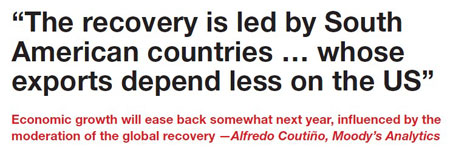EM REGIONAL BANKING FOCUS: LATIN AMERICA
By Denise Bedell
Latin America is a hotbed of growth, presenting a wealth of opportunities for domestic and international banks.

With some of the highest growth rates seen anywhere worldwide this year, Latin America is proving a key destination for foreign direct investment through greenfield development, joint ventures with domestic companies and M&A.; One of the driving factors that makes Latin America so attractive both for direct investment and to portfolio investors is the dichotomy of a commodity-rich region whose wealth is not driven solely by commodity exports. In fact, as J.P. Morgan pointed out in a recent report, although commodities play a big role in exports, neither exports nor commodities are what primarily drive regional GDP growth. “Domestic consumption is the largest driver of Latin American GDP. It is this consumption theme that provides many of the region’s most attractive opportunities,” the report concludes.
Commodities and other exports are, however, central to both domestic growth and foreign investor interest. Exports to the US still account for 43.1% of total exports from Latin America—primarily from Mexico, which still sends 80% of its trade goods to the US. Exports to China continue to grow as well. According to J.P. Morgan, exports to China now account for 7.7% of total international trade for the region.
Alfredo Coutiño, director for Latin America at Moody’s Analytics, says investment in the region focuses on the bigger economies. “Direct investment has been heavier for leading countries in terms of the recovery, stability and potential growth, like in the case of Brazil, Chile, Peru, Colombia and Mexico, to some extent,” he notes.
In addition, international interest is increased by the strides that most Latin American governments are taking to open their markets to global competition. They are working hard to guarantee macroeconomic stability and discipline while at the same time deregulating the markets to open them to private investment. Says Coutiño: “They have learned that foreign investment not only increases the economy’s production capacity but also brings new technologies and production processes, which at the end strengthens the region’s economy.”
Major market opportunities for international investors—both direct and portfolio investors—are enhanced by the increasing strength of the corporate sector. With strong management teams holding vast experience in navigating the economic peaks and troughs that the region has experienced in the past, corporate Latin America came through quite strongly during the recent crisis.
According to the J.P. Morgan report, companies in Latin America showed better balance sheet management than their peers in Europe, the Middle East and Africa or emerging Asia over the past two years. “An analysis of the drivers of profitability in the region demonstrates that Latin American companies have improved profit margins and asset turnover while keeping leverage at consistent levels,” it says.
M&A; Grows Rapidly
Foreign and domestic banks alike are set to enjoy a bonanza as the Latin American M&A; market, particularly in Brazil and Mexico, blossoms. According to data from Thomson Reuters, the three largest announced deals in the region in the first half of the year all involve Mexican companies. Topping the chart was América Móvil’s acquisition of Carso Global Telecom, which was valued at $27.4 billion. Heineken Brewery of the Netherlands ranked second for its purchase of Mexican brewer Femsa for $7.4 billion, and América Móvil came third in the ranking of top transactions as well, picking up a 33% stake in Telmex International for $5.5 billion.

In the Brazilian market, a joint venture between Royal Dutch Shell and Brazilian sugar and biofuels firm Cosan to develop ethanol production assets and other energy distribution channels for $4.92 billion leads the league table, while the $4.9 billion purchase of Brazilian company Vale’s aluminum assets by Norsk Hydro of Norway comes in a close second.
The Venezuelan government also sold off two stakes in its Carabobo region oil development project, bringing in $10 billion or more for state coffers. Plus, there is the joint venture—valued at $3.1 billion—between CNOOC of China and Argentine company Bridas for oil production and reserve development.
In terms of M&A; advisers, Credit Suisse is at the top of the league tables for announced M&A; transactions in the region for the first half of 2010, having been involved in 16 deals with a total value of $52 billion. Citi comes in second, with eight transactions for a total value of $47 billion. Spanish giant Santander ranks third, with involvement in 23 deals for a combined value of $38.5 billion.
Strong Fundamentals
The boom in deal activity is founded on some strong economic fundamentals—Latin America as a whole is forecast to turn in growth of around 5.5% this year, after a contraction of 2.2% last year, according to Moody’s Analytics. The strong growth is mainly fueled by solid domestic markets. “The recovery is led by South American countries—particularly Brazil, Peru, Argentina and Chile—whose exports depend less on the US market,” notes Coutiño. Economic growth will ease back somewhat next year, influenced by the moderation of the global recovery, he says.
Brazil is leading the recovery this year, with expected growth of 7%, after barely contracting at all last year. This growth is focused on a solid domestic market heavily stimulated by economic policy. Coutiño says: “Brazil is a more flexible economy with a heavy agenda of reforms and deregulation, which makes the country more attractive for foreign investment.”
Mexico, on the other hand, is expected to be slower to recover, owing to its dependence on the US for trade. The country could grow as much as 4.5% this year, which is still impressive after the 6%-plus contraction experienced last year.
Chile will also see strong growth this year, albeit less than Brazil, Argentina and Peru. Coutiño puts its 2010 full-year potential growth rate at 5%. He says: “Chile will be one of the best performers in the region next year, mainly supported by the post-earthquake reconstruction process.”
Finally, Argentina should see impressive growth this year—potentially as high as 9%. The country did not enter recession last year, although growth rates did fall to just 0.9%. Some analysts are concerned, though, that its expansionary fiscal and monetary policies are driving growth, which could present some risk over the longer term.
Coutiño says: “This makes the recovery to be more transitory rather than permanent, given the weakness of economic fundamentals. Thus, the economy runs the risk of a significant slowdown in coming years if the country has to incur fiscal and monetary adjustments in case of unexpected internal or external shocks.”
For the banking sector, though, the region looks set to remain a prime source of revenue and profit growth.



